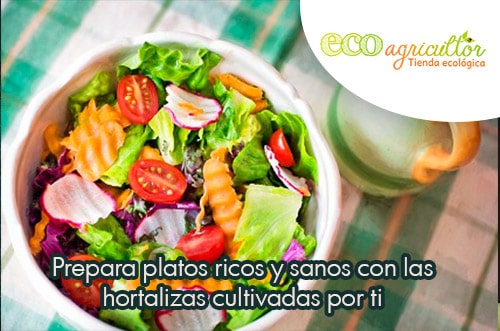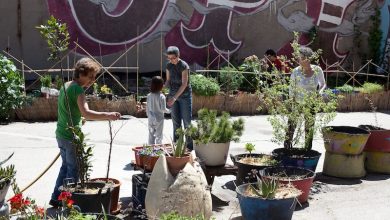What can I grow on a cultivation table in my urban garden?

We are now ready to set up our ecological urban garden : we have read the most important books about gardening, we have the seeds , the necessary tools , the substrate , we even have the compost ready to make organic compost ! We only lack the containers in which to grow: planters , vertical garden structures , the grow boxes and of course, the queens of the urban garden: the grow tables .
Do you want to grow your own aromatic and medicinal plants, vegetables and berries? You just have to read on to learn how to take advantage of a small space at home and enjoy organic gardening .
Growing in urban spaces can pose some challenges, but just as you have flowers on your balcony, terrace or small patio, it is also possible to have an urban garden where you can grow edible aromatic plants and harvest vegetables throughout the year.
If you are still not convinced by the size or style of the pots or you want your small outdoor space to continue being functional to different activities, you can always opt for a grow table .
It is simply a very practical tool that allows you to have an area of »land» at a height that is also comfortable for horticultural work for people of all ages, especially if there is a reduction in mobility.
The cultivation tables can even provide mobility to the garden depending on the time of year or the other uses that the small garden is given at home, much easier by incorporating wheels.
Access now> Why you need a Field Notebook for your Garden, how to create it and an example to download
The control of pests , as well as that of the humidity and quality of the substrate, is much easier than in the ground and it is even possible to incorporate a mini- drip irrigation system .
You can buy grow tables in different sizes and with various accessories, it is even possible to adjust their height, but you can also build it by reusing materials that you have at home or that you can get easily. Among the best known, for example, are those designed with disused pallets , although it is becoming increasingly difficult to get them in good condition and at no cost.
Grow on your grow table step by step

Prepare the grow table
To start using a growing table, it is important to consider that, unlike a pot or any other container, in general the tables will have to be covered with plastic and some drains must be made in it.
Black plastic is recommended, because it can absorb light, preventing the development of fungi on the substrate.
Once placed and well spread, covering the entire bottom and sides, it is stapled or tacked to the edges and it is recommended to make a single hole to place a drain hose.
The substrate
In the cultivation tables, as well as in general in terraces and balconies, soil is not used, since its weight is excessive. Instead, different types of substrate are used , usually in mixes that are prepared or that we can mix on our own.
Among the most used is the mixture of coconut fiber and earthworm humus : while coconut fiber provides aeration to the roots, earthworm humus is rich in organic nutrients that are essential for a good harvest.
Make sure the substrate is 100% organic. The nutrients will be depleted after a few months of cultivation, at which time compost begins to be incorporated about 2 times a year.
Compost offers many advantages by storing water and nutrients that provide all the food that plants require, even in the shallow depth of the cultivation table.
Planting organization
You can be guided by the common sowing calendar or by the lunar calendar .
The next thing: use quality seeds, organic seeds ensure you the best possible start in your urban garden.
Before considering which are the species that will need seedling and transplantation , and those that do not need it because they are direct seeded plants, it is essential to consider the duration of the cycle to have a good planning of the harvests.
The duration of the life cycle of aromatic plants and vegetables is the time from sowing until a harvest can be made.
The first factor to consider is the variety, as there are varieties of the same species that have different cycles. For a small space such as a grow table, short cycle ones are best. Some examples of fast growing vegetables are: spinach, radishes, lettuce, beets, arugula, etc.
Another factor is the climatic conditions, since the plants will mature faster the more temperature and humidity there is in the environment. Being shallow, the temperature varies more rapidly on the cultivation tables than on the ground.
A third key factor is the succession of harvests , interspersing plants that reach maturity in a staggered manner so that, when they reach their maximum development, they do not disturb each other and allow the surface to be used to the maximum.
.
Crop association
Every centimeter is important in an urban garden, and every plant is important in the health of the polyculture.
There are, however, some basic rules in plant compatibility to ensure production on a grow table. Some compete with each other for nutrients through the roots, while others compete for shade or light.
How to associate the plants correctly? I tell you in detail in my last article on crop associations and I also leave you the link to the association table .
Benefits of growing aromatic plants
The association of vegetables with aromatic plants is very beneficial. First of all, because they develop very well and with little demand in small containers. Here I give you some examples .
They attract beneficial garden insects, such as pollinators , and help repel pests that can cause disease.
Read 28 aromatic and medicinal plants that you can grow at home
In addition to increasing the diversity of the garden, they can be very useful in the kitchen, as a condiment, in preparations for dressing salads, or simply adding a refreshing aroma to the environment.
Among the easiest to maintain and most useful, both in the kitchen and in the garden itself, some options are: basil , chives, shallots, coriander , dill , spearmint, lemon balm, mint, oregano , sage, parsley and thyme.
Irrigation system
The basic conditions for planning a home garden are sufficient direct light and water in a nearby place.
The irrigation is one of the activities that require more time in maintaining the garden, since it is a delicate type of planting compared to plantations in soil.
Although watering can be done manually, only with a watering can and very slowly to prevent cracks from forming in the substrate, there are also drip irrigation systems for the grow table scale that can be purchased as an accessory.
The drip irrigation system must be installed after placing the substrate and having given a first irrigation with a watering can so that it settles evenly; but, it must be placed before carrying out any sowing or transplanting.
Direct sowing and seedbeds
As mentioned before, some seeds will have to be sown directly on the cultivation table, while others should first be sown in seedbeds and then transplanted.
The seedbeds or seedlings serve to facilitate the germination of the smallest seeds, which require a little more humidity and temperature, and at the same time, a selection to enhance the development of a seedling that will later be transplanted.
As reference:
- Direct sowing: strawberry, radish, carrot, spinach, parsley and chives.
- Seedlings: turnips, beets, tomatoes, peppers, aubergine, oregano, basil and lettuce.
Harvest and replenish
As mentioned before, for the urban garden to be sustainable, it is important to consider at the time of planting, both the duration of the cycle and the possibility of replacing or rotating as it is harvested.
Radishes can be ready to eat in about 3-4 weeks, while lettuces take about 2 months, carrots are harvested from 3-4 months, and aubergines, peppers, and tomatoes will not be ripe before 6 months. .
Lettuces, radishes and carrots can be replaced immediately after harvesting, but in order to maintain a crop that is possible to consume, it is advisable to stagger the plantings of those that are faster.
With good planning, even on a small grow table, you can ensure delicious salads of lettuce, radishes, carrots and tomatoes, seasoned with chives, parsley, basil or dill for the whole summer, direct to the table from a few meters from your Terrace.
Discover much more practical information for your garden

![Photo of Tamarind Tree: [Cultivation, Irrigation, Associations, Pests and Diseases]](https://www.complete-gardening.com/wp-content/uploads/2022/08/tamarind-tree-cultivation-irrigation-associations-pests-and-diseases-270x220.jpg)


